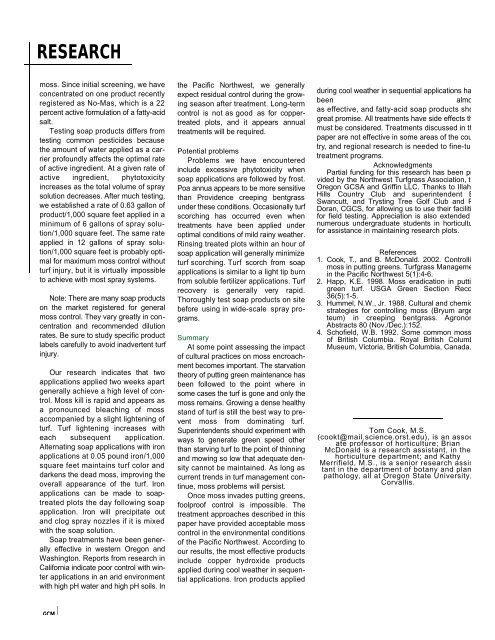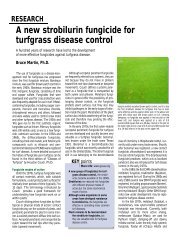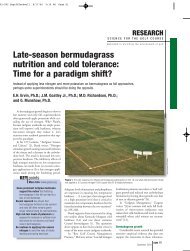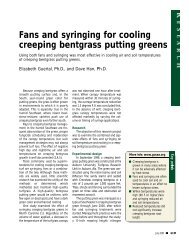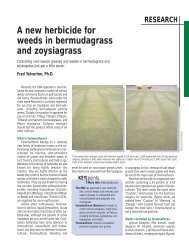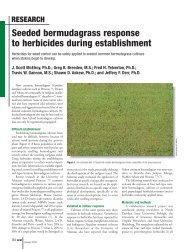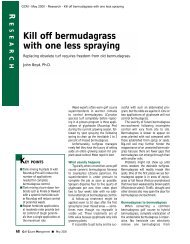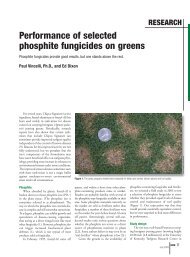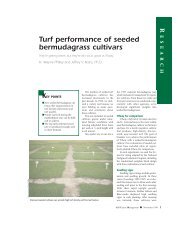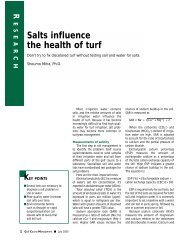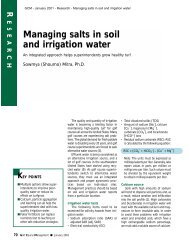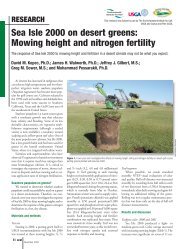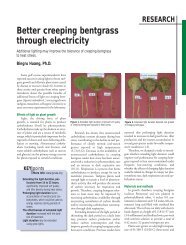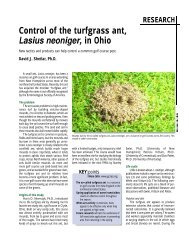Controlling moss in putting greens - GCSAA
Controlling moss in putting greens - GCSAA
Controlling moss in putting greens - GCSAA
You also want an ePaper? Increase the reach of your titles
YUMPU automatically turns print PDFs into web optimized ePapers that Google loves.
RESEARCH<strong>moss</strong>. S<strong>in</strong>ce <strong>in</strong>itial screen<strong>in</strong>g, we haveconcentrated on one product recentlyregistered as No-Mas, which is a 22percent active formulation of a fatty-acids a l t .Test<strong>in</strong>g soap products differs fromtest<strong>in</strong>g common pesticides becausethe amount of water applied as a carrierprofoundly affects the optimal rateof active <strong>in</strong>gredient. At a given rate ofactive <strong>in</strong>gredient, phytotoxicity<strong>in</strong>creases as the total volume of spraysolution decreases. After much test<strong>in</strong>g,we established a rate of 0.63 gallon ofproduct/1,000 square feet applied <strong>in</strong> am<strong>in</strong>imum of 6 gallons of spray solution/1,000square feet. The same rateapplied <strong>in</strong> 12 gallons of spray solution/1,000square feet is probably optimalfor maximum <strong>moss</strong> control withoutturf <strong>in</strong>jury, but it is virtually i m p o s s i b l eto achieve with most spray systems.Note: There are many soap productson the market registered for general<strong>moss</strong> control. They vary greatly <strong>in</strong> concentrationand recommended dilutionrates. Be sure to study specific productlabels carefully to avoid <strong>in</strong>advertent turf<strong>in</strong>jury.Our research <strong>in</strong>dicates that twoapplications applied two weeks apartgenerally achieve a high level of control.Moss kill is rapid and appears asa pronounced bleach<strong>in</strong>g of <strong>moss</strong>accompanied by a slight lighten<strong>in</strong>g ofturf. Turf lighten<strong>in</strong>g <strong>in</strong>creases witheach subsequent application.Alternat<strong>in</strong>g soap applications with ironapplications at 0.05 pound iron/1,000square feet ma<strong>in</strong>ta<strong>in</strong>s turf color anddarkens the dead <strong>moss</strong>, improv<strong>in</strong>g theoverall appearance of the turf. Ironapplications can be made to soaptreatedplots the day follow<strong>in</strong>g soapapplication. Iron will precipitate outand clog spray nozzles if it is mixedwith the soap solution.Soap treatments have been generallyeffective <strong>in</strong> western Oregon andWash<strong>in</strong>gton. Reports from research <strong>in</strong>California <strong>in</strong>dicate poor control with w<strong>in</strong>terapplications <strong>in</strong> an arid environmentwith high pH water and high pH soils. Inthe Pacific Northwest, we generallyexpect residual control dur<strong>in</strong>g the grow<strong>in</strong>gseason after treatment. Long-termcontrol is not as good as for coppertreatedplots, and it appears annualtreatments will be required.Potential problemsProblems we have encountered<strong>in</strong>clude excessive phytotoxicity whensoap applications are followed by frost.Poa annua appears to be more sensitivethan Providence creep<strong>in</strong>g bentgrassunder these conditions. Occasionally turfscorch<strong>in</strong>g has occurred even whentreatments have been applied underoptimal conditions of mild ra<strong>in</strong>y weather.R<strong>in</strong>s<strong>in</strong>g treated plots with<strong>in</strong> an hour ofsoap application will generally m<strong>in</strong>imizeturf scorch<strong>in</strong>g. Turf scorch from soapapplications is similar to a light tip burnfrom soluble fertilizer applications. Tu r frecovery is generally very rapid.Thoroughly test soap products on sitebefore us<strong>in</strong>g <strong>in</strong> wide-scale spray progr a m s .S u m m a r yAt some po<strong>in</strong>t assess<strong>in</strong>g the impactof cultural practices on <strong>moss</strong> encroachmentbecomes important. The starvationtheory of putt<strong>in</strong>g green ma<strong>in</strong>tenance hasbeen followed to the po<strong>in</strong>t where <strong>in</strong>some cases the turf is gone and only the<strong>moss</strong> rema<strong>in</strong>s. Grow<strong>in</strong>g a dense healthystand of turf is still the best way to prevent<strong>moss</strong> from dom<strong>in</strong>at<strong>in</strong>g turf.Super<strong>in</strong>tendents should experiment withways to generate green speed otherthan starv<strong>in</strong>g turf to the po<strong>in</strong>t of th<strong>in</strong>n<strong>in</strong>gand mow<strong>in</strong>g so low that adequate densitycannot be ma<strong>in</strong>ta<strong>in</strong>ed. As long ascurrent trends <strong>in</strong> turf management cont<strong>in</strong>ue,<strong>moss</strong> problems will persist.Once <strong>moss</strong> <strong>in</strong>vades putt<strong>in</strong>g <strong>greens</strong>,foolproof control is impossible. T h etreatment approaches described <strong>in</strong> thispaper have provided acceptable <strong>moss</strong>control <strong>in</strong> the environmental conditionsof the Pacific Northwest. Accord<strong>in</strong>g toour results, the most effective products<strong>in</strong>clude copper hydroxide productsapplied dur<strong>in</strong>g cool weather <strong>in</strong> sequentialapplications. Iron products applieddur<strong>in</strong>g cool weather <strong>in</strong> sequential applications habeenalmoas effective, and fatty-acid soap products shogreat promise. All treatments have side effects thmust be considered. Treatments discussed <strong>in</strong> thpaper are not effective <strong>in</strong> some areas of the cout r y, and regional research is needed to f<strong>in</strong>e-tutreatment programs.AcknowledgmentsPartial fund<strong>in</strong>g for this research has been provided by the Northwest Turfgrass Association, thOregon GCSA and Griff<strong>in</strong> LLC. Thanks to IllaheHills Country Club and super<strong>in</strong>tendent BSwancutt, and Tryst<strong>in</strong>g Tree Golf Club and PaDoran, CGCS, for allow<strong>in</strong>g us to use their facilitiefor field test<strong>in</strong>g. Appreciation is also extended tnumerous undergraduate students <strong>in</strong> horticulturfor assistance <strong>in</strong> ma<strong>in</strong>ta<strong>in</strong><strong>in</strong>g research plots.References1. Cook, T., and B. McDonald. 2002. Controll<strong>in</strong><strong>moss</strong> <strong>in</strong> putt<strong>in</strong>g <strong>greens</strong>. Turfgrass Managemen<strong>in</strong> the Pacific Northwest 5(1):4-6.2. Happ, K.E. 1998. Moss eradication <strong>in</strong> putt<strong>in</strong>green turf. USGA Green Section Reco36(5):1-5.3. Hummel, N.W., Jr. 1988. Cultural and chemicastrategies for controll<strong>in</strong>g <strong>moss</strong> (Bryum argenteum) <strong>in</strong> creep<strong>in</strong>g bentgrass. A g r o n o mAbstracts 80 (Nov./Dec.):152.4. Schofield, W.B. 1992. Some common <strong>moss</strong>eof British Columbia. Royal British ColumbiMuseum, Victoria, British Columbia, Canada.Tom Cook, M.S.(cookt@mail.science.orst.edu), is an assocate professor of horticulture; BrianMcDonald is a research assistant, <strong>in</strong> thehorticulture department; and KathyMerrifield, M.S., is a senior research assistant <strong>in</strong> the department of botany and planp a t h o l o g y, all at Oregon State University,C o r v a l l i s .GCM


